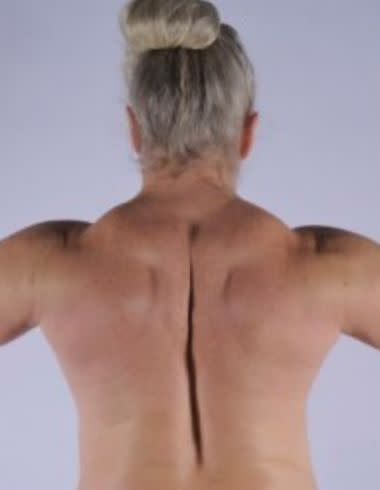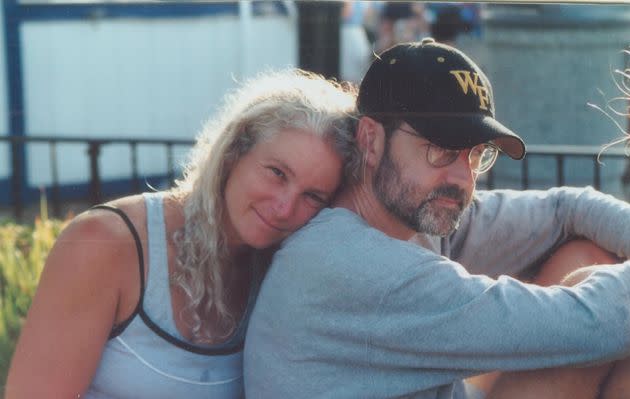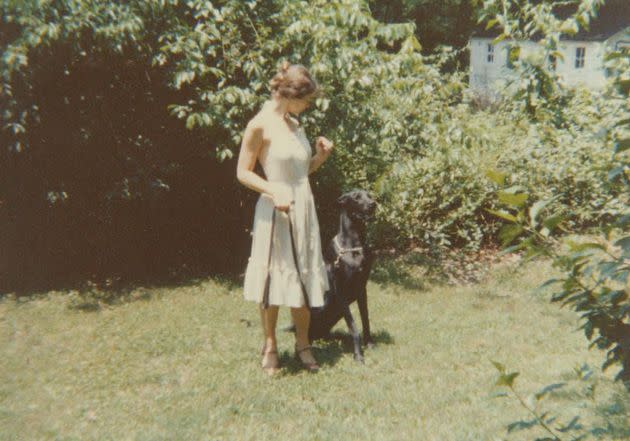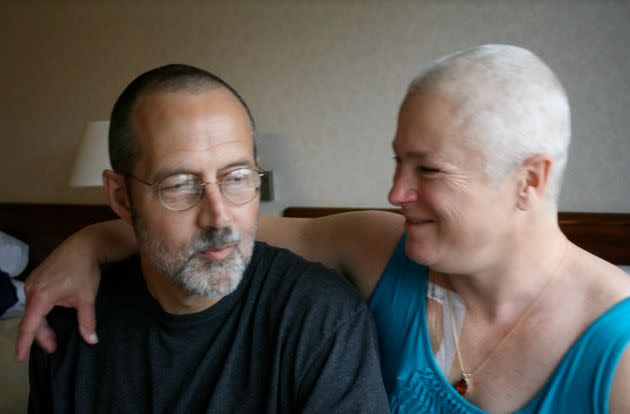My Muscles Mysteriously Began Growing So Fast I Thought They Might Kill Me

The author's back and shoulders in 2009, two years after her muscles began growing rapidly. (Photo: Courtesy of Sally Massagee)
In November 2007, a communication glitch delayed scheduling a doctor’s appointment, and I almost exploded. This would be the seventh doctor I’d seen in eight months because my muscles had grown so big. They looked buff, but my muscles also tightened and weakened as they grew. My biceps had grown too muscular and weak for me to put on earrings or adjust a turtleneck. When I watered the red impatiens hanging on my front porch, I had to rest between plants.
After I finally scheduled the doctor’s appointment, I calmed down and wondered at the rage I’d felt. I realized I was scared that I would die, that whatever was happening to my body would kill me ― soon. Too soon.
I was 52 and had always been strong and healthy. I had a husband, five children and an accounting business, and I wanted to live. But as I searched for a doctor who could give me answers, the stress of running my life as my body weakened turned everything gray. After weeks of hunting and stressing, I realized that whether I had 30 days or 30 years left, I would live those days more fully if I could lay down my fear.
No problem, I thought. Now that I see how fear is damaging whatever time I do have, I’ll just stop being afraid. But my trapezius muscles tightened so much that I felt pain. Work deadlines swirled, my breath came fast and my body couldn’t relax.
I decided that when I felt stressed, I would stop and ask myself what, exactly, I feared. Was it that I wouldn’t finish a tax return in time, or that I would need a wheelchair soon, or that my muscles would eventually smother me? Then I crafted a mental picture of a great outcome: delivering the tax return, starting to jog again, breathing easy. Expect good things, I told myself. Expect. Good. Things.
It turned out to be a good plan, and the process helped me. But dealing with my fear wasn’t an easy or occasional exercise. It was more like the time years before when my toddler daughter flung pumpkin puree at the wall. I wiped the pumpkin away, sprayed the remaining orange spot with Fantastik, and scrubbed. Then I stepped back to see a bright white spot on a wall that had collected grime so gradually over the years that no one noticed the slow accumulation. I realized the whole wall of my thought habits needed a good cleaning.

The author with her husband, Buddy, in 1992. (Photo: Courtesy of Sally Massagee)
By May 2008, my doctors still had not figured out why my muscles were growing. It started with my shoulders, then my biceps and forearms, and then my quads and calves. Then my back was bulking. My lower back muscles tightened in irregular bunches that hurt when I walked for too long, which soon became just a block.
I used a CPAP breathing machine to control the sleep apnea that had started when my muscles went amok. The machine needed a higher setting each month. What happens, I asked the neurologist, when it maxes out?
He sent me to an otolaryngologist who threaded a tiny camera through my nose and down my throat. He told me the swath of muscles expanding under my chin was tongue muscle. He could cut away some tongue, but the real problem was that the muscles on either side of my spine were closing in my throat. He wouldn’t touch those.
I kept trying to imagine good things. It didn’t give my doctors answers, or loosen my muscles or create more energy, but it did calm me. As I became less reactive and frantic, people connected more fully. I brought a more present energy to my tasks.
Mostly, I had more fun. My home responsibilities and my work were in my life because I loved them. I couldn’t do more stuff when I put down my fear, but I did enjoy living more. I joked with my clients. I teased one of my daughters. I savored the scent of sauteing onion as I rested between the now-exhausting steps of cooking dinner.
Doctors originally suspected acromegaly, a condition in which, usually, a benign tumor on the pituitary gland prompts the body to make extra growth hormone. But my endocrinologist was certain, based on blood tests, that I did not have acromegaly.
In June 2007, near the beginning of my search for what was wrong with me, an MRI had shown no tumor. In May 2008, a second MRI showed a pituitary growth. The surgeon said that lots of people got them ― maybe as much as 15% of the population ― but that they often appeared temporarily and were usually not a problem.
The surgeon resisted doing invasive surgery, which would involve going through my nose to the pituitary gland nestled against the brain. The procedure, even when successful, often left patients needing hormone treatment for the rest of their lives. But there was no other pony in the race, so we moved forward with plans to remove the growth.

The author in 1977. (Photo: Courtesy of Sally Massagee)
I checked into the hospital. Still uneasy about the surgery, my doctor ordered another MRI. Two hours before surgery the following morning, I sat in a Naugahyde recliner in my hospital room and wondered what awaited me.
My doctors at this top medical center had exhausted their ideas of where else to look for an answer to my condition. And as certain as I’d been the whole time that my body would eventually stop growing, my muscles continued to bulk. How, exactly, how, how could I expect good things if this one last possibility was ruled out? I closed my eyes and sat quietly until the grasping feeling in my gut stopped. My breath came full and deep, and peace settled over me.
I called my husband, who was at our favorite local cafe ordering breakfast before my surgery, and asked him to get me a breakfast burrito in case we didn’t go through with it.
“I’m really worried about what happens to you if they don’t operate,” he said.
“I’ll be OK,” I said.
“Hmmph.”
Shortly before the procedure was due to begin, my surgeon entered my room.
“I guess you’re wondering about results,” he said. “I waited for my best radiologist to get back from a seminar to have a look. There is no growth. The nurse will bring your discharge papers.”
“Things like this happen ― more often than you’d expect,” the nurse told me. “Sometimes there’s a greater power at work.”
I felt in my bones that I’d had no immediate, miraculous healing. My body was the same inert, stubborn self it had become over the previous two years. Still, I wondered, was the nurse right? Was a big life force at work, moving me toward some wonderful conclusion? Or was it just that pituitary growths come and go, and many people have them at times, and this wasn’t what was responsible for my muscles bulking?
I was right: I’d had no instantaneous healing. And the doctors still didn’t know where to look for an answer.
The following months brought countless opportunities to practice putting down my fears and instead trying to enjoy my life, as difficult as it had become. Crafting a mental picture of a happy outcome helped me to savor these moments, even as death looked more and more certain. I bought a stool so I could sit and rest every few minutes as I made dinner. But I still put on jazz and opened the windows to enjoy the cross breeze while I cooked, just as I’d always done.

The author and Buddy in 2009. (Photo: Courtesy of Sally Massagee)
Finally there was a breakthrough, and my doctors diagnosed me with a rare manifestation of a terminal disease: AL amyloidosis, which causes cells in the bone marrow to send an abnormal protein out into the body, usually to the heart or kidney, and often ends up being fatal. My protein first went to my muscles.
There is no cure for AL amyloidosis, but treatment can give patients more time. In June 2009, I had a stem cell transplant at Mayo Clinic in Minnesota, far from our home in western North Carolina. And it did give me more time ― lots more. I’ve never asked how much time to expect. I enjoy imagining a long horizon before me, and that might be harder to picture if I knew the statistics.
Since my transplant, I’ve often walked a length of Folly Beach in South Carolina. Scrub pines stretch ahead to the left, and ocean waves lap to the right, making a long corridor of sand in between. I walk toward what looks like a dead end as the water extends out for miles. But as I approach the waves ahead, I reach the end of the scrub pines and a new vista of coastline opens to the side, ready for me to turn the corner onto the continued path.
I’ve hunted a quote that says being able to tolerate a lack of closure is a prerequisite for joy. I can’t find the quote. Maybe no one said it, but if not, someone should.
I live on in my body that has been changed, both from when I was well and from when I was at my sickest. My muscles have softened and grown smaller, but they’re bigger than at the start of this journe. I walk, now more slowly. I stretch and gently move toward a fuller range of motion than I’ve had recently. I work, cook dinner and connect with friends, now with a more centered and open presence, as though approaching death deepened the days I have left.
My Mayo Clinic doctor tells me she’ll likely know before I do if the condition becomes active again and if we need to consider a second transplant. I hear that to mean I won’t know right away ― not directly from my body ― if it’s heading again toward a death that’s sooner than “sometime.”
Every three months I send blood and urine to Mayo Clinic. As I wait for results, I savor the moments. That quarterly wait reminds me to stretch and grow in new ways, to take the kids for ice cream, to soak up the beauty of the trees. I could die soon. Or not. And whatever is ahead for me, and however soon or not, right now, life, with all its brevity, immensity and mystery, feels sweet.
Sally Massagee lives in western North Carolina with her husband and Great Dane. She’s hard at work on a memoir, “Whole.” You can visit her online at sallymassagee.com.
Do you have a compelling personal story you’d like to see published on HuffPost? Find out what we’re looking for here and send us a pitch.
This article originally appeared on HuffPost and has been updated.
